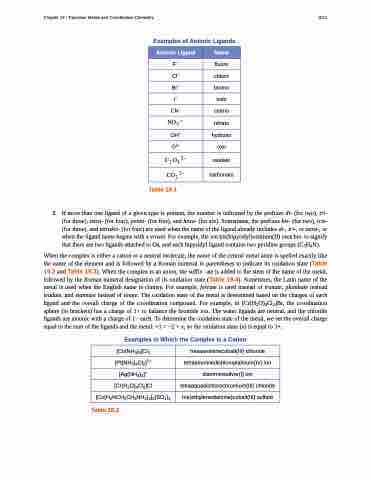Page 1081 - Chemistry--atom first
P. 1081
Chapter 19 | Transition Metals and Coordination Chemistry 1071
Examples of Anionic Ligands
Anionic Ligand
Name
F−
fluoro
Cl−
chloro
Br−
bromo
I−
iodo
CN−
cyano
����
nitrato
OH−
hydroxo
O2–
oxo
�� �� ��
oxalato
��� ��
carbonato
Table 19.1
3. If more than one ligand of a given type is present, the number is indicated by the prefixes di- (for two), tri- (for three), tetra- (for four), penta- (for five), and hexa- (for six). Sometimes, the prefixes bis- (for two), tris- (for three), and tetrakis- (for four) are used when the name of the ligand already includes di-, tri-, or tetra-, or when the ligand name begins with a vowel. For example, the ion bis(bipyridyl)osmium(II) uses bis- to signify that there are two ligands attached to Os, and each bipyridyl ligand contains two pyridine groups (C5H4N).
When the complex is either a cation or a neutral molecule, the name of the central metal atom is spelled exactly like the name of the element and is followed by a Roman numeral in parentheses to indicate its oxidation state (Table 19.2 and Table 19.3). When the complex is an anion, the suffix -ate is added to the stem of the name of the metal, followed by the Roman numeral designation of its oxidation state (Table 19.4). Sometimes, the Latin name of the metal is used when the English name is clumsy. For example, ferrate is used instead of ironate, plumbate instead leadate, and stannate instead of tinate. The oxidation state of the metal is determined based on the charges of each ligand and the overall charge of the coordination compound. For example, in [Cr(H2O)4Cl2]Br, the coordination sphere (in brackets) has a charge of 1+ to balance the bromide ion. The water ligands are neutral, and the chloride ligands are anionic with a charge of 1− each. To determine the oxidation state of the metal, we set the overall charge equal to the sum of the ligands and the metal: +1 = −2 + x, so the oxidation state (x) is equal to 3+.
Examples in Which the Complex Is a Cation
Table 19.2
[Co(NH3)6]Cl3
hexaamminecobalt(III) chloride
[Pt(NH3)4Cl2]2+
tetraamminedichloroplatinum(IV) ion
[Ag(NH3)2]+
diamminesilver(I) ion
[Cr(H2O)4Cl2]Cl
tetraaquadichlorochromium(III) chloride
[Co(H2NCH2CH2NH2)3]2(SO4)3
tris(ethylenediamine)cobalt(III) sulfate


